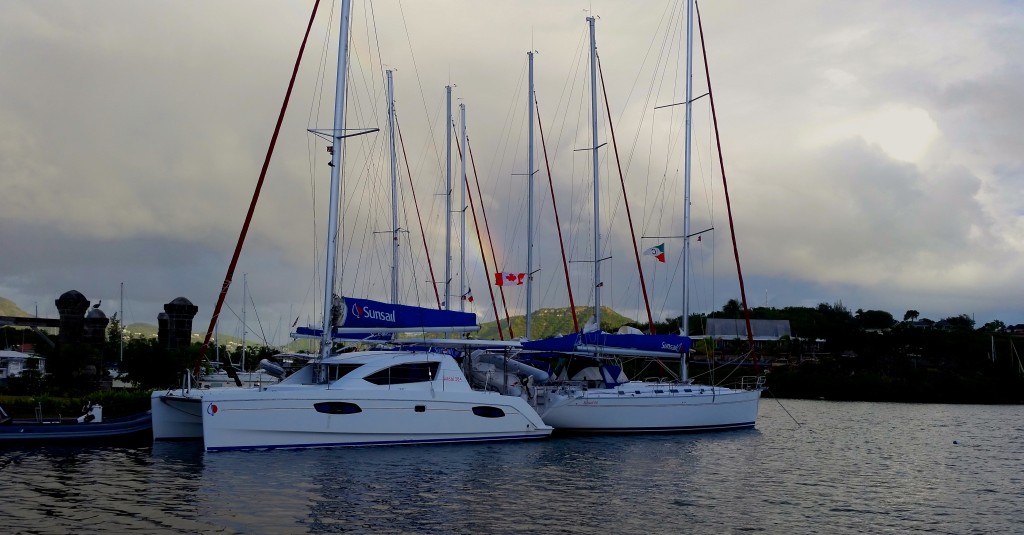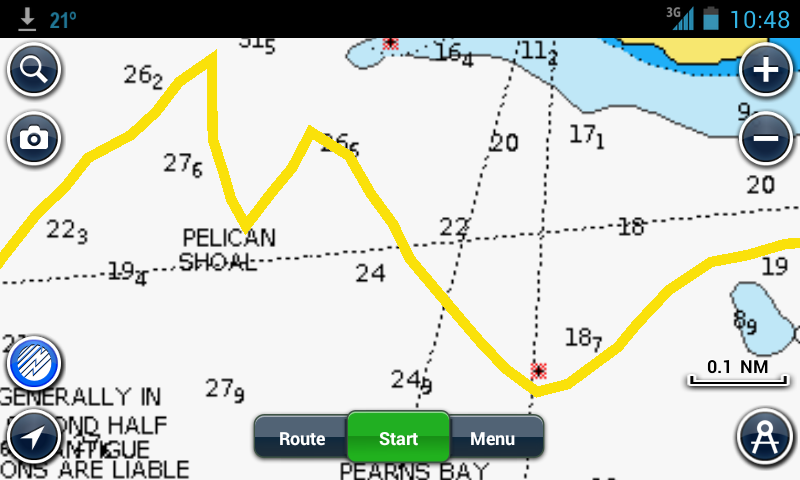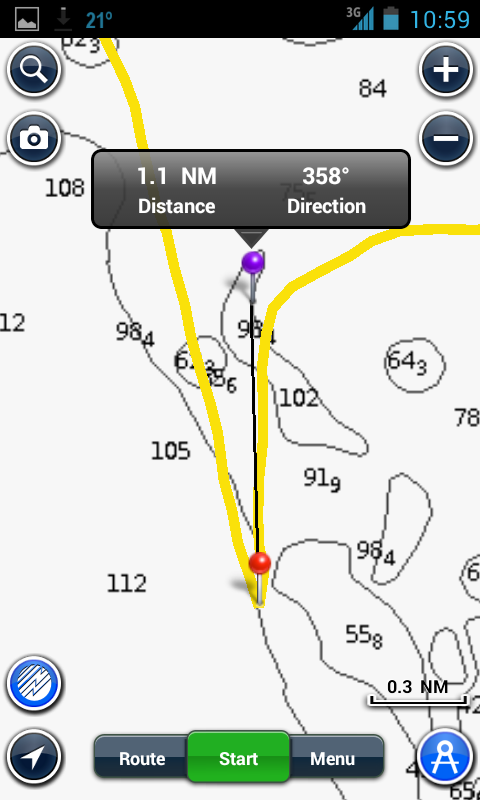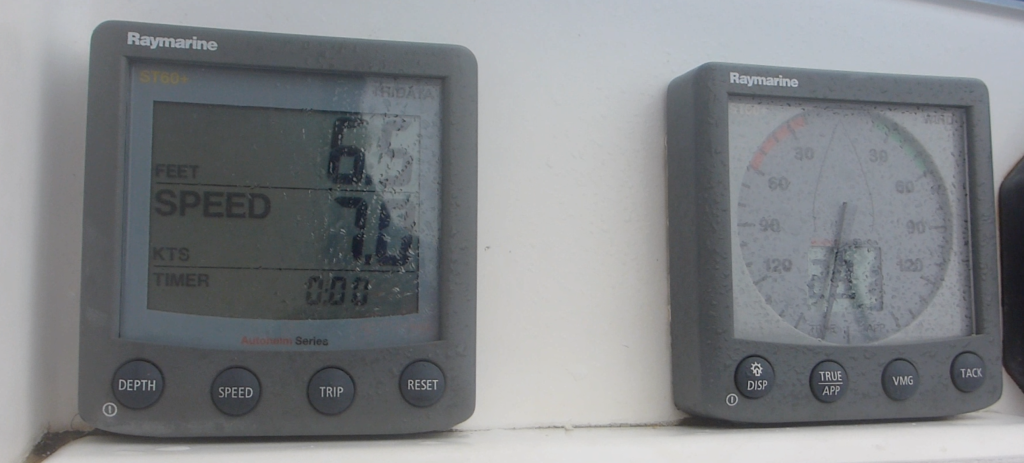With 17 people signed up we were going to need at least two boats. This, combined with the limited availability of boats in Antigua meant that we couldn’t get two matching boats to accommodate everyone.
We settled on a 38′ catamaran and a 50′ monohull. We had wanted to try a cat for a while, had some people along who get seasick who might benefit from the stability and the two were similarly priced so the costs would be evenly split.
This way we got to compare the two side by side and come up with some meaningful differences.

Sailing performance
Reaching
It was mostly tradewind sailing so most of our sailing was reaching. The mono averaged 8-9 knots and the catamaran would do about 7-8 knots.
The sailing experience was quite different though. On the cat the bows were digging into the 4-5′ seas and the bridgedeck was regularly lopping off the tops of waves. Even when it was flatter, the motion was erratic and the sounds of rushing wind and water were loud. It was exhilarating sailing unless you were one of those who were seasick.
On the fifty I am told it was comfortable sailing. The displacement smoothed out the chop enough so that the very gradual 6′ north swells were noticeable whereas on the cat they were lost in the erratic motion. That matches my experience sailing 40’ monohulls on a reach in similar sea states.
Winner: Tie
Upwind
There were two opportunities to compare upwind sailing capabilities. The first first was sailing close hauled to Coco Point in Barbuda. We were protected from the seas by the reefs extending south from Barbuda so the water was flat, the seas were 1’ or less. As the fifty and the cat hardened up the fifty pulled away. She lost about a knot of boat speed but was still making better than 7 knots.
The first thing I noticed close hauled on the cat was, just like in beach cats, upwind the rudders are as effective as brakes as they are as rudders. Hardened up the Cat was making about 5.5 knots, down about 2 knots but if you over-steered she quickly dropped down to 3 knots. Both boats were able to point equally well, just short of making it up the recommended course for approaching Coco point. On the catamaran our apparent wind angle was about 35° degrees apparent.
We noticed similar upwind performance when beating into Five Islands Harbor while the fifty (who had left an hour earlier that day) motored about looking for the best place to anchor. Our upwind track looked very similar to many of those that I’ve drawn on 35’-40’ monohulls.

On the way back to Antigua, in the open seas with 4’-5’ wind driven waves it was a different story. The cat’s auto-pilot wouldn’t point closer than 50° from the apparent wind making 5-6 knots without regularly catching a wave poorly and losing much of her forward speed. Hand steering we could get a bit closer to the wind but this required all one’s attention and, in all honesty, catamaran helming skills that we simply didn’t have. Trying to keep the boat powered up without using more than a few degrees of rudder meant anticipating waves quite far out. Add in the erratic motion messing with your steering inputs and you’ve got a recipe for frustration.

Before we switched tacks we had been running on autopilot keeping the apparent wind about 60° and the boat speed between 7 and 8 knots (in 15-19 knots of apparent wind) so the south-heading track wasn’t our highest course; of course we’d tried to edge up to 50° apparent earlier but that brought us back down to about 5 knots of boat speed again. After a bit less than half an hour we decided that we should just motor dead upwind for a bit so we could keep our boat speed up for the rest of the leg by keeping the wind at 60° apparent. We figured that would be the fastest and most comfortable way to finish the remaining 15nm.
The motion motoring dead upwind was just on the tolerable side of miserable. But the rest of the day was fast, comfortable, enjoyable sailing.
In flat water the cat is a bit slow upwind. When seas become a factor our charter cruising cat had a hard time sailing to windward.
Winner: Monohull
Downwind
Charter boats simply aren’t outfitted with effective downwind sails. Full Stop.
Using the sails we had, the catamaran sailed well enough downwind. The fifty didn’t point as deep downwind as we were used to. The additional hull speed made it that much easier for the larger boat to outrun her wind, thereby making the angle comfortable downwind higher than it would be in the smaller monohulls we were used to. The cat didn’t have as much momentum as the fifty so outrunning the wind wasn’t an issue; when the wind relented the boat slowed down.
Hand Steering the cat could hold 150° apparent. On autopilot we could keep the wind at about 130° apparent. Even in 3’-4’ seas on the quarter. With both sails up, every time we gybed, we gybed too late and wound up heading up after the gybe; our sense of when to gybe came from our monohull experience and it lead us astray.
In lighter winds it was fascinating to see how a few degrees course change would alter the apparent wind. This video was shot without trimming in for the new apparent wind of 90°. Once those adjustments were made we gained around a knot of boatspeed and the apparent wind was closer to 80°. Next time I’ll do the math to determine if the VMG was better with the apparent wind at 130° or 80-90°.
The fifty did one 24nm mostly downwind passage that took them better than 6 hours in 10-13 knots of wind. That’s an average of 4 knots VMG, pretty terrible contrasted with the 7-9 knots they’d been sailing reaching and upwind. They wound up motoring to make it in before sunset.
There was another day of downwind sailing when both boats had just a double reefed jib deployed and we were seeing 25-30 knots of wind. That was an adventurous day. We had no trouble maintaining 160° apparent without the main blanketing the jib.

It was an amazing ride on the catamaran, especially once you closed the door and appreciated the comfort of the salon.
I was pleasantly surprised with the downwind pointing ability and performance of the chartered cruising catamaran. Both the fifty and the cat would have benefited sailing downwind with downwind sails added to their sail inventory.
Winner: Catamaran
Accommodations
On Deck
The catamaran was the hands down winner here. Adding the saloon to the “on deck” accommodation is a huge win for space. The width of the catamaran translated into easier moving around and more. When we were tied up to the dock the Catamaran was the preferred place to hang out (though our awesome tunes and bottomless painkillers also probably contributed to this favoritism). We were able to have a dance party aboard where most of the dancers were standing on the seats so there was plenty of headroom.
If you wanted to get away from the music you could head to the bow/trampoline for some quiet. We fit the whole crew of 8 on the bow comfortably hanging out. There was no issue with moving around while grilling at the stern.
On this charter the fifty really lost out because the dodger and the bimini couldn’t be taken down which really hampered moving between the cockpit and the deck and lent a very cramped feeling to the cockpit when everyone was hanging out. With those additional impediments it was no contest.
Winner: Catamaran
Below Deck
The fifty definitely had the more spacious berths, the ceilings were taller and the the galley was more workable by two people contrasted with the catamaran’s wrap around galley that only really accommodated one chef at a time. Below, the fifty had plenty of room for moving around. With everyone in the main saloon the fifty felt spacious and moving about was no problem. Even with 14 people it still felt spacious.
The catamaran’s saloon had space for moving about but when you tried to put the whole crew in it got cramped. Plus there wasn’t as much stowage and the overflow wound up in the saloon taking away some of the space that could have otherwise been used for people.
Winner: Monohull
Motion
Underway
The catamaran’s motion was stable and erratic simultaneously; something I wouldn’t believe if I hadn’t experienced it myself. I absentmindedly set a mostly finished bottle of coke on the table and a few minutes later was shocked to find it still sitting right where I left it. I was compelled to record evidence of it sitting there comfortably:
But walking around on the cat you felt like you were trying to balance on a subdued mechanical bull; I used more handholds underway than I normally do on a monohull. The same people who were prone to seasickness on monohulls underway were prone to seasickness on the catamaran while it was underway.
I didn’t get onboard the fifty but I’ve been on similar size and displacement boats. These would be great sailing conditions but anything that didn’t get stowed would wind up on the cabin sole.
Winner: Catamaran
At Anchor
Even though we chose Antigua for it’s reputation for more protected anchorages we spent most nights with some swell or wave reflection rolling us around.
The catamaran’s stability really shone at anchor. Several crew who’ve tended toward seasickness from the gentle to and fro of a monohull at anchor didn’t encounter the same queasyness aboard the catamaran at all; even the morning after overdoing it with the rum. Getting a good night’s sleep was definitely appreciated by these crew.
One of the other sailors along had the following to say about the catamaran at anchor: “The few times I was on the catamaran I found the motion at anchor unsettling. It was jerky as I recall. Perhaps I would have gotten used to it had I been on for more than an hour at any one time. It was definitely a nice platform for hanging out.” So that’s a caveat for some of us who are used to overnighting on monohulls.
Winner: Catamaran
Overall
If you favor sailing capabilities go with the Monohull. If you favor comfort at anchor and underway choose the Catamaran. If you need more space below (more crew/gear) the monohull will better accommodate you at the same price point.
The only things that I found that surprised me were:
- The saloon of the cat is calmer than on a monohull contrasted to the more exciting sailing experience on deck
- The catamaran sailed upwind better than expected in flat seas
- How much more room below the 50 foot monohull had
I love sailing fast and sailing well as much as the next sailor. I’ve got lots of experience sailing monohulls well and given the conditions typical to chartering locations I know the sailing experience on the monohull would be favorable.
That said, if we do another charter with a catamaran as one of the boats I’d be up for the challenge of trying to sail it well. Sure, it would be more frustrating but that’s mostly because I’d be learning a lot. I’m likely to find myself sailing another charter cat in the next few years. Wish me luck!
PS; If the dodger and bimini don’t come down you’ll always find me on the cat!
Were the cat and mono similar in charter price and did they take the same number of people? bareboat or crewed? Which was more maneuverable in close quarters under power? The cat was a Leopard 38 but what was the mono (looks like a Beneteau Oceanis)? Did the cat’s extra width or mono’s extra length present any other difficulties?
The price was similar. We had 8 on the Cat (listed capacity 10) and 9 on the monohull (listed capacity 12). We were bareboating. I talk a bit about actual capacity here
I’ll be sharing information about the costs in a future post. Sign up for the mailing list and you’ll get notified when I make that update.
You’re right about the cat. The mono was similar to a Jeanneau Sun Odyssey. We were moored or anchored during our trip so the additional length nor width presented a problem.
Thanks!